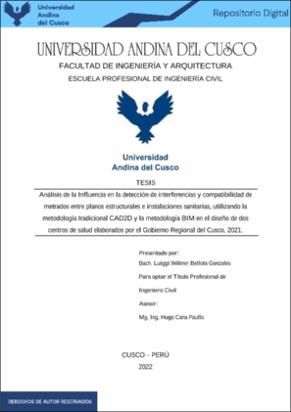| dc.contributor.advisor | Cana Paullo, Hugo | |
| dc.contributor.author | Bellota Gonzales, Luiggi Wilmer | |
| dc.date.accessioned | 2023-03-28T14:42:30Z | |
| dc.date.available | 2023-03-28T14:42:30Z | |
| dc.date.issued | 2022-12-21 | |
| dc.identifier.uri | https://hdl.handle.net/20.500.12557/5260 | |
| dc.description.abstract | La presente investigación “Análisis de la Influencia en la detección de interferencias entre
planos estructurales e instalaciones sanitarias, utilizando la metodología tradicional CAD2D y
la metodología BIM en el diseño de dos centros de salud elaborados por el G.R.C”, tuvo como
objetivo analizar de manera comparativa los rendimientos en la aplicación de ambas
metodologías. Realizando la medición de manera indirecta para los datos de la metodología
tradicional CAD2D y de manera directa para la metodología de trabajo BIM, ambos en la etapa
diseño de proyectos. Asimismo, para la compatibilización de metrados.
Los casos de estudios fueron los proyectos de edificación de categoría esencial tipo centro de
salud “Mejoramiento de los servicios de salud del centro de salud Ttio, distrito de Wanchaq,
provincia de Cusco, región – Cusco” y “Mejoramiento de los Servicios de Salud en el centro de
Salud de Pomacanchi, Distrito de Pomacanchi, Provincia de Acomayo, Región Cusco”, ambos
proyectos elaborados por la Sub Gerencia de Estudios de Inversión del Gobierno Regional de
Infraestructura, Gobierno Regional del Cusco.
Esta investigación se llevó a cabo a partir de un marco teórico donde se analizó antecedentes
que se asemejan al tema, desde una perspectiva nacional e internacional. También se desarrolló
los conceptos básicos y fundamentales que conciernen a la implementación de la metodología
de trabajo BIM, sus antecedentes donde fueron ya implementados y la retroalimentación que
estos generan para futuros proyectos.
La metodología abarcada en esta investigación tiene un enfoque cuantitativo, con un nivel
descriptivo – correlacional, empleando un método aplicado cuyo diseño metodológico es no
experimental.
De los resultados se concluye que la Influencia en la detección de interferencias e
incompatibilidad de metrados entre planos estructurales e instalaciones sanitarias, utilizando la
metodología BIM es más eficiente frente a la metodología tradicional CAD2D en la etapa de
diseño. | es_PE |
| dc.description.abstract | The present investigation "Analysis of the Influence in the detection of interferences between
structural plans and sanitary installations, using the traditional CAD2D methodology and the
BIM methodology in the design of two health centers elaborated by the G.R.C", had as
objective to analyze in a comparative way yields in the application of both methodologies.
Performing the measurement indirectly for the data of the traditional CAD2D methodology
and directly for the BIM work methodology, both in the project design stage. Likewise, for the
compatibility of metrics. The case studies were the building projects of essential category type
health center "Improvement of health services of the Ttio health center, district of Wanchaq,
province of Cusco, region - Cusco" and "Improvement of Health Services in the Pomacanchi
Health Center, Pomacanchi District, Acomayo Province, Cusco Region", both projects
prepared by the Sub Management of Investment Studies of the Regional Government of
Infrastructure, Regional Government of Cusco. The investigation was carried out from a
theoretical framework where antecedents that resemble the subject were analyzed, from a
national and international perspective. The basic and fundamental concepts that concern the
implementation of the BIM work methodology were also developed, their background where
they were already implemented and the feedback they generate for future projects. The
methodology covered in this research has a quantitative approach, with a descriptive -
correlational, using an applied method whose methodological design is non-experimental.
From the results it is concluded that the influence on the detection of interferences and
incompatibility of measurements between structural plans and sanitary facilities, using the BIM
methodology is more efficient compared to the methodology traditional CAD2D in the design
stage. | en_US |
| dc.format | application/pdf | es_PE |
| dc.language.iso | spa | es_PE |
| dc.publisher | Universidad Andina del Cusco | es_PE |
| dc.rights | info:eu-repo/semantics/openAccess | es_PE |
| dc.rights.uri | https://creativecommons.org/licenses/by-nc-nd/4.0/ | es_PE |
| dc.subject | Implementación | es_PE |
| dc.subject | Interferencias | es_PE |
| dc.subject | Metrados | es_PE |
| dc.subject | Compatibilización | es_PE |
| dc.title | Análisis de la influencia en la detección de interferencias y compatibilidad de metrados entre planos estructurales e instalaciones sanitarias, utilizando la metodología tradicional CAD2D y la metodología BIM en el diseño de dos centros de salud elaborados por el Gobierno Regional del Cusco, 2021 | es_PE |
| dc.type | info:eu-repo/semantics/bachelorThesis | es_PE |
| thesis.degree.name | Ingeniero Civil | es_PE |
| thesis.degree.grantor | Universidad Andina del Cusco. Facultad de Ingeniería y Arquitectura | es_PE |
| thesis.degree.discipline | Ingeniería Civil | es_PE |
| dc.publisher.country | PE | es_PE |
| dc.subject.ocde | https://purl.org/pe-repo/ocde/ford#2.01.00 | es_PE |
| renati.advisor.dni | 40331257 | |
| renati.advisor.orcid | https://orcid.org/0000-0003-4551-5449 | es_PE |
| renati.author.dni | 46808499 | |
| renati.discipline | 732016 | es_PE |
| renati.juror | Cabezas Mancilla, José Humberto | |
| renati.juror | Alvarez Alvarez, Goyo | |
| renati.juror | Ascue Escalante, Kildare Jussety | |
| renati.juror | Arenas Lazarte, Javier | |
| renati.level | https://purl.org/pe-repo/renati/level#tituloProfesional | es_PE |
| renati.type | https://purl.org/pe-repo/renati/type#tesis | es_PE |


